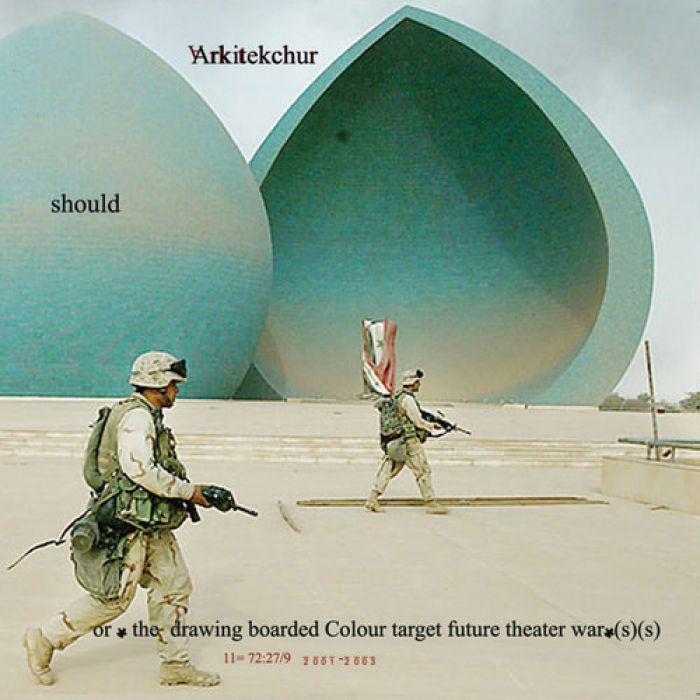Should or The Drawing Boarded Colour Target Future Theater Wars by Arkitekchur (Review)

The artwork for this CD consists of all manner of charged and disturbing imagery — American troops walking in front of an Iraqi monument; overhead shots of the World Trade Center devastation; Middle-Eastern children playing with guns; an image of a deformed fetus set next to a photo of Bush and his advisors in front of the White House; military maps depicting nuclear fallout’s effects on the U.S. — and the liner notes reference books by Nobel Peace Prize nominees and quote government documents concerning American foreign policy.
Taken at face value, the album smells to high heaven of conceptual agitprop so pretentious, conceptual, and epic — the CD is nearly 73 minutes long — that it would make even the entire Constellation Records stable blush.
Thankfully, it is nothing of the sort, awkward album and song titles aside. Joseph Lisciandro, the enigma behind Arkitekchur, wisely leaves the blatant and obvious imagery on the CD sleeve. While the occasional Godspeed-esque field recording or vocal sample does surface, and the music threatens to surge forth in a huge climax at times, Arkitekchur keeps the music subtle, thought-provoking, and quite captivating. Indeed, compared to the artwork’s violent and horrific imagery, the music is quite subdued by comparison, full of seemingly endless guitar drones, delicate atmospherics, and the occasional bit of percussion.
At times, you get the distinct impression that these songs (if you can call these drifting compositions “songs”) were composed to counterbalance and even provide relief from the troubling things documented by the artwork. The opening track, “Rite Words” begins with faint rumblings and eerie, disembodied voices, but these soon fade away, revealing a delicate weave of crystalline guitars and fluttering, ethereal electronics in the vein of Aarktica. Over the next 15 minutes, the song continues to build on its repetitive, hypnotic structure, summoning together more and more gorgeous textures until the song gracefully disintegrates.
A similar phenomena occurs on the aptly-titled “How To Pray Using The Mysteries Of Light Theme.” Running nearly 23 minutes in length, this could be the one song that David Pearce has been trying to write his entire life. Grounded by echoing, clattering drums that strike up an almost tribal timbre, the song becomes nigh-transcendental as waves of shimmering guitar drones and textures dreamily wash over it with an oceanic grace.
But there is darkness and anxiety lying just below the surface of Arkitekchur’s music, be it in the form of disturbing vocal samples; or the ominous drones, chimes, and other sounds that drift, stalker-like, behind the more pleasant ones (“Rancoqeaux Woods”); or the sudden bursts of noise that erupt without warning, possibly inducing heart attacks among less stalwart listeners. Thankfully, the CD handily avoids becoming pretentious and overwrought during these darker moments.
Even in the CD’s darkest and most obtuse stretches, such as “Rancoqeaux Woods” or “Jealousy” with its tense, alien atmospheres, Lisciandro shows admirable restraint, successfully weaving together sounds both lovely and disturbing. “Symbol/Language>Discourse” has a sort of abstract beauty to it, even as a man intones “Your children are not safe” and a woman describes some sort of medical procedure amidst blurred tones and bells, and before the song explodes into a blistering wall of static. And the aforementioned “How To Pray Using The Mysteries Of Light Theme,” for all of its beauty, still finds rumbles and odd tones occasionally filtering through, heightening the danger and causing you to appreciate the song’s lovelier aspects all the more.
But perhaps the album’s most compelling moment comes during “Anandamide” (which gets its name from a bliss-inducing compound found in both marijuana and chocolate — how’s that for subversive?). It almost seems cliched as I describe the song — against a barely-there yet still-ominous backdrop, the delicate tones of a music box emerge playing “You Are My Sunshine.” And it does seem rather trite and “obvious.”
But as the song continues, and the music box slowly winds down until its once-bright melody more resembles a sorrowful dirge, it becomes a surprisingly tense and nerve-wracking listen as you wait for the inevitable end. An experience which proves to be far more sobering and effective at communicating the themes of Arkitekchur’s music — brooding themes of anxiety and confusion, hope and longing — than any of the charged imagery that Lisciandro uses as its packaging.